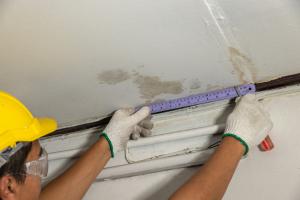Identifying Mold: Recognizing the Signs, Smells, and Hidden Risks
Mold can develop in areas that are difficult to inspect, such as behind walls or under flooring”
HAMMOND, LA, UNITED STATES, December 6, 2024 /EINPresswire.com/ -- Mold growth in homes and businesses poses significant risks to structural integrity and health. Gulf52, a disaster mitigation and restoration company based in Hammond, Louisiana, emphasizes the importance of early detection and intervention to address mold issues. Understanding the visual indicators, distinct odors, and concealed dangers of mold can help property owners take proactive steps to manage this persistent problem.— Earl Carr, Jr.
Mold thrives in damp environments, often following water damage caused by flooding, leaks, or humidity. Left unaddressed, it can spread rapidly, damaging materials such as drywall, wood, and insulation while potentially causing respiratory issues and other health concerns. Early identification is essential to mitigating these risks.
“Mold can develop in areas that are difficult to inspect, such as behind walls or under flooring,” said Earl Carr, Jr.2, president of Gulf52. “Recognizing the signs and taking immediate action to address moisture issues is key to preventing extensive damage and health problems.”
Visual Signs of Mold
Mold is often visible in the form of discoloration or staining on surfaces. Common signs include:
Black, Green, or White Patches: These may appear on walls, ceilings, or floors, especially in areas exposed to moisture.
Peeling or Bubbling Paint: Excessive moisture can cause paint to bubble or peel, which may indicate hidden mold growth beneath the surface.
Water Spots: Persistent stains from water leaks often serve as a breeding ground for mold.
Mold does not always grow in visible areas. It can thrive in hidden spaces, such as behind wallpaper, inside HVAC systems, or beneath carpets. Regular inspections and moisture control are critical to addressing these hidden risks.
Smells Associated with Mold
One of the most recognizable indicators of mold is its distinct odor. Mold often produces a musty or earthy smell, which may become noticeable before any visual signs appear.
Persistent Musty Odor: If a property has an ongoing damp smell, even after cleaning, mold may be present.
Localized Odors: In cases where the smell is stronger in certain rooms or areas, mold is likely growing in concealed spaces nearby.
Relying solely on smell, however, is not sufficient for identifying mold. Professional inspection may be required to locate the source and extent of the issue.
Hidden Dangers of Mold
Mold often grows in areas that are out of sight, making it challenging to detect without proper tools or expertise. These hidden growths can cause significant damage over time.
Structural Damage: Mold weakens building materials, such as wood and drywall, compromising the structural integrity of a property.
Airborne Spores: Mold releases microscopic spores that can spread throughout a property, affecting air quality and contributing to respiratory issues.
Health Risks: Prolonged exposure to mold can cause or exacerbate conditions such as allergies, asthma, and other respiratory illnesses.
Carr highlighted the importance of addressing hidden mold promptly, stating, “The dangers of mold are often underestimated. Mold hidden behind walls or in ventilation systems can affect both the structure of a building and the health of its occupants. Regular inspections and early remediation are essential to managing these risks.”
Addressing Mold Concerns
Once mold is identified, it is essential to address the underlying cause, typically a moisture issue. Steps for remediation may include:
Fixing Leaks: Identifying and repairing any plumbing, roof, or foundation leaks to eliminate moisture sources.
Removing Damaged Materials: Mold-infested materials, such as drywall or insulation, may need to be removed and replaced.
Improving Ventilation: Increasing airflow in damp areas to reduce humidity and prevent mold growth.
Professional mold remediation services ensure that mold is removed safely and effectively. Experts use specialized equipment to detect hidden mold and ensure complete removal, preventing regrowth.
Prevention Strategies
Preventing mold growth requires ongoing attention to moisture control and property maintenance. Key strategies include:
Monitoring Humidity Levels: Keeping indoor humidity below 50 percent to discourage mold development.
Using Dehumidifiers: In areas prone to high humidity, dehumidifiers help maintain optimal conditions.
Inspecting Vulnerable Areas: Regularly checking basements, attics, and bathrooms for signs of water damage or mold.
Maintaining HVAC Systems: Ensuring ventilation systems are clean and functioning properly to prevent moisture buildup.
Implications for Property Owners
Mold can have far-reaching consequences for property owners, impacting both health and property value. Addressing mold early can reduce restoration costs, minimize disruptions, and prevent long-term damage.
For insurance purposes, documenting mold growth and any associated water damage is crucial. Accurate records, including photographs and professional assessments, streamline the claims process and support efforts to recover restoration costs.
Supporting Community Health and Safety
Identifying and addressing mold is part of maintaining safe and healthy living and working environments. Property owners, restoration professionals, and local organizations must work together to raise awareness about the risks of mold and the importance of early detection.
As flooding and extreme weather events become more frequent, mold-related challenges are likely to increase. Investing in education, inspections, and prevention measures will help communities respond effectively to these growing risks.
About Gulf52
Gulf52 specializes in disaster mitigation, restoration, and construction services for residential, commercial, and industrial properties. Based in Hammond, Louisiana, the company provides tailored solutions to address the challenges of water damage, mold growth, and property restoration across the Gulf Coast region.
Morgan Thomas
Rhino Digital, LLC
+1 504-875-5036
email us here
Visit us on social media:
Facebook
1 https://gulf52.com
2 https://gulf52.com/about-us/


